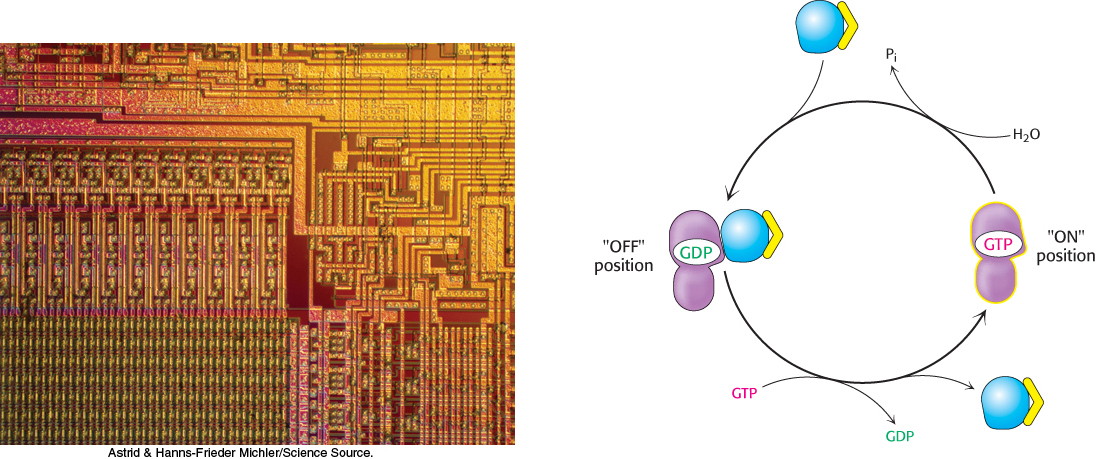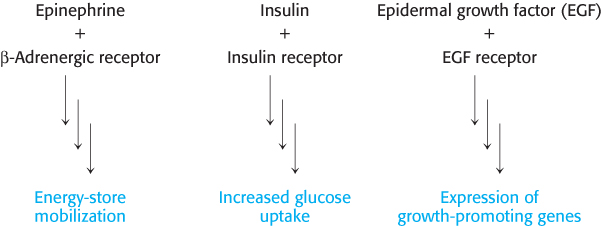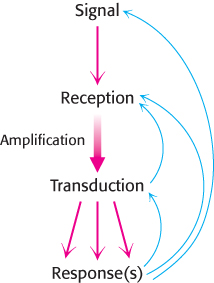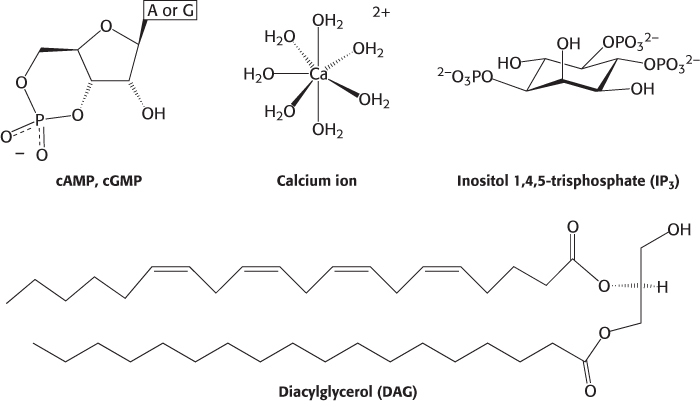Chapter Introduction
Signal-
397

OUTLINE
Heterotrimeric G Proteins Transmit Signals and Reset Themselves
Insulin Signaling: Phosphorylation Cascades Are Central to Many Signal-Transduction Processes
EGF Signaling: Signal-Transduction Systems Are Poised to Respond
Many Elements Recur with Variation in Different Signal-Transduction Pathways
Defects in Signal-Transduction Pathways Can Lead to Cancer and Other Diseases
A cell is highly responsive to specific chemicals in its environment: it may adjust its metabolism or alter gene-
Signal-

398
Signal transduction depends on molecular circuits
Signal-
Release of the Primary Messenger. A stimulus such as a wound or digested meal triggers the release of the signal molecule, also called the primary messenger.
Reception of the Primary Messenger. Most signal molecules do not enter cells. Instead, proteins in the cell membrane act as receptors that bind the signal molecules and transfer the information that the molecule has bound from the external environment to the cell’s interior. Receptors span the cell membrane and thus have both extracellular and intracellular components. A binding site on the extracellular side specifically recognizes the signal molecule (often referred to as the ligand). Such binding sites are analogous to enzyme active sites except that no catalysis takes place within them. The interaction of the ligand and the receptor alters the tertiary or quaternary structure of the receptor so as to induce a structural change on the intracellular side.
Delivery of the Message Inside the Cell by the Second Messenger. Other small molecules, called second messengers, are used to relay information from receptor–
ligand complexes. Second messengers are intracellular molecules that change in concentration in response to environmental signals and mediate the next step in the molecular information circuit. Some particularly important second messengers are cyclic AMP (cAMP) and cyclic GMP (cGMP), calcium ion, inositol 1,4,5- trisphosphate (IP3), and diacylglycerol (DAG; Figure 14.3).  Figure 14.2: Principles of signal transduction. An environmental signal is first received by interaction with a cellular component, most often a cell-
Figure 14.2: Principles of signal transduction. An environmental signal is first received by interaction with a cellular component, most often a cell-surface receptor. The information that the signal has arrived is then converted into other chemical forms, or transduced. Typically, the transduction process comprises many steps. The signal is often amplified before evoking a response. Feedback pathways regulate the entire signaling process.  Figure 14.3: Common second messengers. Second messengers are intracellular molecules that change in concentration in response to environmental signals. That change in concentration conveys information inside the cell.
Figure 14.3: Common second messengers. Second messengers are intracellular molecules that change in concentration in response to environmental signals. That change in concentration conveys information inside the cell.The use of second messengers has several consequences. First, the signal may be amplified significantly: only a small number of receptor molecules may be activated by the direct binding of signal molecules, but each activated receptor molecule can lead to the generation of many second messengers. Thus, a low concentration of signal in the environment, even as little as a single molecule, can yield a large intracellular signal and response. Second, these messengers are often free to diffuse to other cellular compartments where they can influence processes throughout the cell. Third, the use of common second messengers in multiple signaling pathways creates both opportunities and potential problems. Input from several signaling pathways, often called cross talk, may alter the concentration of a common second messenger. Cross talk permits more finely tuned regulation of cell activity than would the action of individual independent pathways. However, inappropriate cross talk can result in the misinterpretation of changes in second-
messenger concentration. Activation of Effectors That Directly Alter the Physiological Response. The ultimate effect of the signal pathway is to activate (or inhibit) the pumps, channels, enzymes, and transcription factors that directly control metabolic pathways, gene expression, and the permeability of membranes to specific ions.
Termination of the Signal. After a cell has completed its response to a signal, the signaling process must be terminated or the cell loses its responsiveness to new signals. Moreover, signaling processes that fail to terminate properly can have highly undesirable consequences. As we will see, many cancers are associated with signal-
transduction processes that are not properly terminated, especially processes that control cell growth.
399
In this chapter, we will examine components of the three signal-